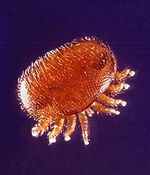Difference between revisions of "Varroa destructor"
Jump to navigation
Jump to search
| Line 1: | Line 1: | ||
| + | {{unfinished}} | ||
| + | |||
[[Image:Varroa Mite .jpg|right|150px|thumb|Kika De La Garza Subtropical Agricultural Research Center Weslaco, Texas, USA (Wikimedia Commons)]] | [[Image:Varroa Mite .jpg|right|150px|thumb|Kika De La Garza Subtropical Agricultural Research Center Weslaco, Texas, USA (Wikimedia Commons)]] | ||
[[Image:Varroa Mite on honeybee pupa.jpg|right|150px|thumb|Kika De La Garza Subtropical Agricultural Research Center Weslaco, Texas, USA (Wikimedia Commons)]] | [[Image:Varroa Mite on honeybee pupa.jpg|right|150px|thumb|Kika De La Garza Subtropical Agricultural Research Center Weslaco, Texas, USA (Wikimedia Commons)]] | ||
| − | + | {| cellpadding="10" cellspacing="0" border="1" | |
| + | | Also known as: | ||
| + | | ''The honeybee mite'' | ||
| + | |- | ||
| + | |} | ||
| + | |||
*'''Notifiable disease in the UK''' | *'''Notifiable disease in the UK''' | ||
| Line 28: | Line 35: | ||
[[Category:Miscellaneous_Mites]] | [[Category:Miscellaneous_Mites]] | ||
| − | [[Category:To_Do_- | + | |
| + | [[Category:To_Do_-_AimeeHicks]] | ||
Revision as of 14:01, 14 July 2010
| This article is still under construction. |
| Also known as: | The honeybee mite |
- Notifiable disease in the UK
- Oval
- 1-1.5mm in length
- Eggs are laid in the hive and develop with the brood cells
Pathogenesis
- Blood-sucking
- Weakens adult bees
- Damages growing larval bees resulting in deformities
Control
- Acaricidal strips hung between combs
- Destroy colonies in apiary (if isolated outbreak)
- Monitor mite numbers and treat if widespread

